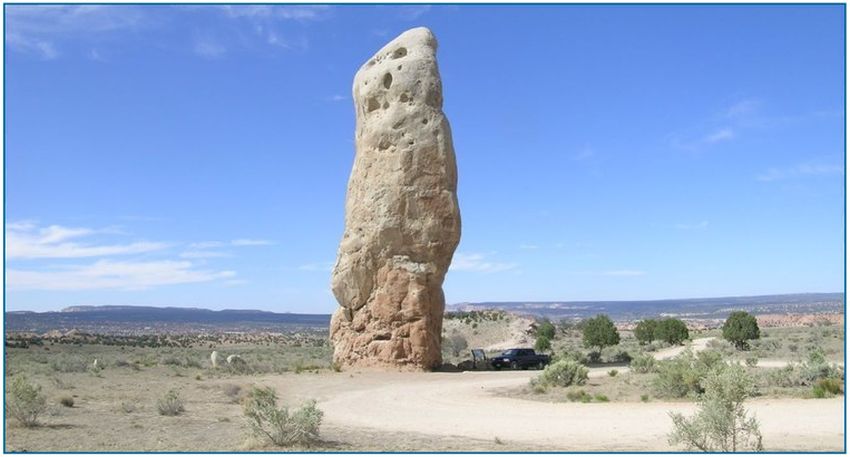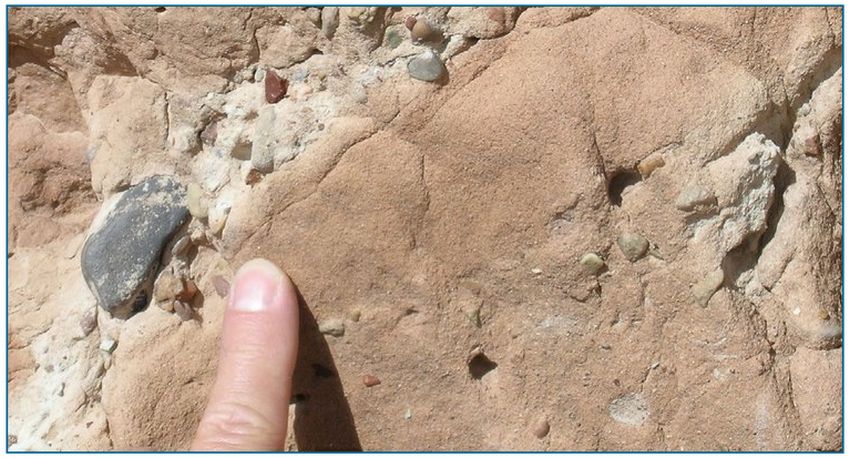Journal of Creation 35(2):7–8, August 2021
Browse our latest digital issue Subscribe
What is the origin of clastic pipes?
While examining sedimentary rocks in detail, uniformitarian scientists regularly discover perplexing features. True to form, they almost always apply present processes over long periods of time to explain their origin. Sometimes, the feature cannot be attributed to present processes, i.e. it does not comply with the uniformitarian principle. In these cases, a secondary hypothesis is applied, or many hypotheses are developed by different researchers. These may or may not be reasonable. One of these perplexing features is clastic pipes (figure 1).

What are clastic pipes?
Clastic pipes are defined as “cylindrical columns of sandstone, which vertically crosscut original bedding with sharp contacts.”1 Some are 100 m in diameter and up to about 100 m tall.2 Up to 100 or more pipes are sometimes found in a given area (figure 2). Occasionally, clastic pipes contain conglomerate or breccia, as those in Kodachrome Basin State Park, Utah, USA (figure 3). Clastic pipes are found within sediment or remain standing after the enclosing layers have eroded away. Clastic pipes can show much variability, such as flaring geometries at the top and bottom,3 and concentric rings.4 Others have unusual weathering pits up to 10 m deep at the top.5 It is believed that the pipes formed at the same time as the sediment was laid down.4

Clastic pipes common in sedimentary rocks
Clastic pipes have been observed at many locations of the world:
“Injectites, including clastic pipes and dikes, have been documented in ancient deposits worldwide, including studies in California (Sherry et al., 2012), Namibia (Moses and Cartwright, 2010), Patagonia (Hubbard et al., 2007), the Mediterranean (Frey-Martinez et al., 2007), and the North Sea (Duranti and Hurst 2004).”1
Clastic pipes are common throughout the Phanerozoic of the Colorado Plateau.3 Over 100 clastic pipe locations are found in southeast Utah alone.6

Uniformitarian scientists not sure how the clastic pipes formed
Since sand dikes and boils are also observed after some earthquakes today, uniformitarian scientists think clastic dikes must be caused by liquefaction or fluidization related to earthquake shaking.7 It is possible they are right, but the exact origin of clastic pipes still eludes them. So, many hypotheses have been developed:
“Scientists have posed multiple hypotheses for the mechanism of pipe formation, including liquefaction from earthquakes (Obermeier, 1996) or meteorite impacts (Alvarez et al., 1998), coldwater springs (Hannum, 1980; Guhman and Pederson, 1992; Draganits et al., 2003), gypsum dissolution (Hunter et al., 1992), groundwater movement (Dubiel et al., 2014), and dewatering (Phoenix 1958).”1
Apparently, there are no modern analogues, which means that clastic dikes contradict the uniformitarian principle:
“Although there are no known modern analogues to these huge masses of structureless sandstone, they may have a small-scale modern counterpart in earthquake-induced sandblows.”8
Sand blows or boils are really not good analogs for clastic pipes since they are small scale and commonly not cylindrical in cross-section below the ground.
Creation science implications
Creation scientists can agree that clastic pipes likely were caused by liquefaction during earthquake shaking.9 However, the quakes would have to be extraordinarily powerful, as would be expected during the global Flood: “The depth of liquefaction recorded by the pipes [in SE Utah] far exceeds depths usually considered in earthquake engineering.”10
The sediments were apparently soft during the formation of the pipes, since there was no disturbance of the surrounding sediments and no indication of compressive strain.9,11 From the uniformitarian perspective, the sediments would have had to remain soft for millions of years. Depending upon the precise uniformitarian date of the pipes, the sediments would have had to remain soft for a minimum of 13 Ma if the Carmel Formation averaged 179 Ma and the Entrada averaged 166 Ma.11 But if Hornbacher is correct that the pipes are Plio-Pleistocene in age, then all the sediments in the region and the hundreds of metres eroded from the area had to remain soft for about 150 Ma.9 Neither scenario is likely.
It is interesting that numerous pipes are found in what uniformitarian scientists consider lithified desert sands. For instance, they are common in the Navajo Sandstone, considered the largest lithified sand erg on Earth. The Navajo Sandstone is considered to have accumulated in a dry sand desert.4 However, the Navajo Sandstone does have features that indicate it was not ‘dry’, such as widespread soft-sediment features indicative of dewatering,12 ‘stromatolites’ that form in water,13 carbonate layers with ‘tufa’ mounds,14 crocodile fossils,12 widespread petrified tree stumps and trees,15 and numerous tracks of dinosaurs and other creatures.16 Based on these observations, it is very likely that the Navajo Sandstone is not a desert sandstone, but was laid down in water, in the same way as what is now considered to be the origin of the classical ‘desert’ Coconino Sandstone.17
References and notes
- Wheatley, D.F. and Chan, M.A., Clastic pipes and soft-sediment deformation of the Jurassic Carmel Formation, southern Utah, USA: implications for pipe formation mechanisms and host-rock controls, J. Sedimentary Research 88:1076, 2018. Return to text.
- Netoff, D., Seismogenically induced fluidization of Jurassic erg sands, south-central Utah, Sedimentology 59:65–80, 2002. Return to text.
- Wheatley, D.F., Chan, M.A., and Sprinkel, D.A., Clastic pipe characteristics and distribution throughout the Colorado Plateau: implications for paleoenvironment and paleoseismic controls, Sedimentary Geology 344:20–33, 2016. Return to text.
- Chan, M.A., Hasiotis, S.T., and Parrish, J.T., Enigmatic clastic pipe swarms and implications for fluidization dynamics in aeolian deposits, Sedimentology 66:513–535, 2019. Return to text.
- Netoff, D.I. and Shroba, R.R., Conical sandstone landforms cored with clastic pipes in Glen Canyon National Recreation Area, southeast Utah, Geomorphology 39:99–110, 2001. Return to text.
- Huuse, M., Shoulders, S.J., Netoff, D.I., and Cartwright, J., Giant sandstone pipes record basin-scale liquefaction of buried dune sands in the Middle Jurassic of SE Utah, Terra Nova 17:80–85, 2005. Return to text.
- Wheatley et al., ref. 1, pp. 1076–1095. Return to text.
- Netoff, ref. 2, p. 65. Return to text.
- Hornbacher, D., Geology and Structure of Kodachrome Basin State Reserve and Vicinity, Kane and Garfield Counties, Utah, M.S. thesis, Loma Linda University, 1985. Return to text.
- Huuse et al., ref. 6, p. 80. Return to text.
- Roth, A.A., Clastic pipes and dikes in Kodachrome Basin, Origins 19(1):44–48, 1992. Return to text.
- Bryant, G., Cushman, R., Nick, K., and Miall, A., paleohydrologic controls on soft-sediment deformation in the Navajo Sandstone, Sedimentary Geology 344:205–221, 2016. Return to text.
- Eisenberg, L., Giant stromatolites and a supersurface in the Navajo Sandstone, Capitol Reef National Park, Utah, Geology 31(2):111–114, 2003. Return to text.
- Dorney, L.J., Parrish, J.T., Chan, M.A., and Hasiotis, S.T., Petrography and environmental interpretation of tufa mounds and carbonate beds in the Jurassic Navajo Sandstone of southeastern Utah, U.S.A., J. Sedimentary Research 87:967–985, 2017. Return to text.
- Parrish, J.T. and Falcon-Lang, H.J., Coniferous trees associated with interdune deposits in the Jurassic Navajo Sandstone Formation, Utah, USA, Palaeontology 50(4):829–843, 2007. Return to text.
- Loope, D.B. and Rowe, C.M., Long-lived pluvial episodes during deposition of the Navajo Sandstone, J. Geology 111:223–232, 2003. Return to text.
- Whitmore, J.H. and Garner, P.A., The Coconino Sandstone (Permian, Arizona, USA): implications for the origin of ancient cross-bedded sandstones; in: Whitmore, J.H. (Ed), Proceedings of the Eighth International Conference on Creationism, Creation Science Fellowship, Pittsburgh, PA, pp. 581–627, 2018. Return to text.




Readers’ comments
Comments are automatically closed 14 days after publication.